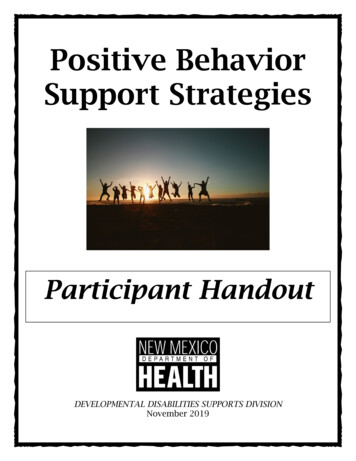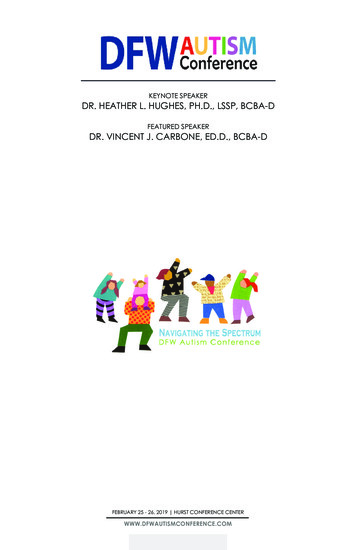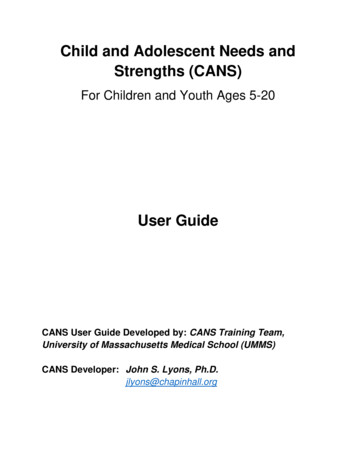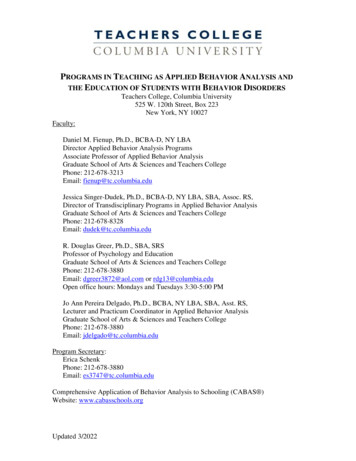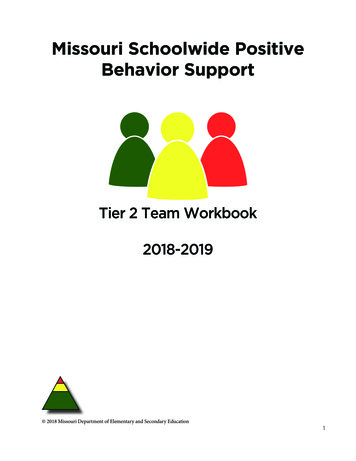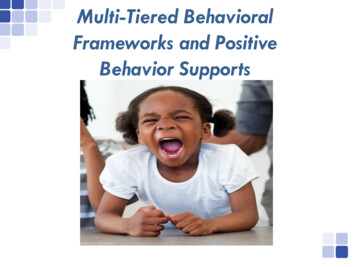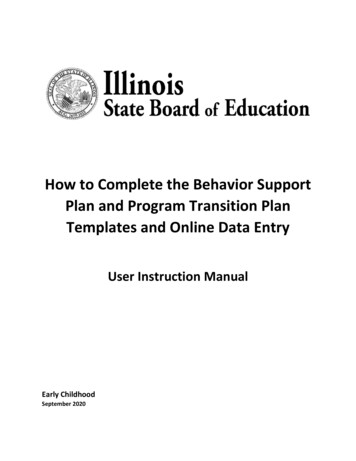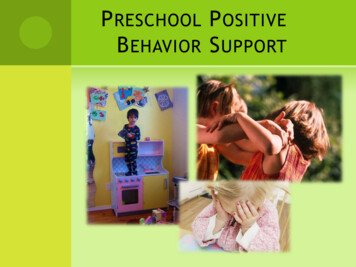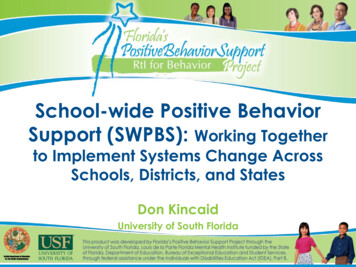
Transcription
School-wide Positive BehaviorSupport (SWPBS): Working Togetherto Implement Systems Change AcrossSchools, Districts, and StatesDon KincaidUniversity of South Florida
What is School-wide PositiveBehavior Support?The application of evidence-basedstrategies and systems to assist schools toincrease academic performance,increase safety, decrease problembehavior, and establish positive schoolcultures.2
PositiveBehaviorSupportSocial Competence,Academic Achievement, and aff BehaviorPRACTICESSupportingStudent BehaviorCenter for Positive Behavior Interventions and Supports (2002)
Tiered Model of School Supports andthe Problem-Solving ProcessIntensive, Individualized Supports Intensive interventions based on individual student needs Students receiving prolonged interventions at this level may be several grade levels behindor above the one in which they are enrolled Progress monitoring occurs most often to ensure maximum acceleration of studentprogress If more than approximately 5% of students are receiving support at this level, engage in Tier1 and Tier 2 level, systemic problem-solvingTargeted, Supplemental Supports Interventions are based on data revealing that students need more than core, universalinstruction Interventions and progress monitoring are targeted to specific skills to remediate or enrich,as appropriate Progress monitoring occurs more frequently than at the core, universal level to ensure thatthe intervention is working If more than approximately 15% of students are receiving support at this level, engage inTier 1 level, systemic problem-solvingCore, Universal Supports Research-based, high-quality, general education instruction and support4 Screening and benchmark assessments for all students Assessments occur for all students Data collection continues to inform instruction If less than approximately 80% of students are successful given core, universal instruction,4engage in Tier 1 level problem-solving
How Do Schools Typically Respond?Reactive/Consequence Strategies– Office referral, detention, suspensions, etc.– Consequences will not teach the “right way”– Consequences may actually reinforce the behavior ofconcernRestrictive and segregated settingsIndividual counseling and therapyImplement packaged programs5
Levels of PBSAdapted from Levels and Descriptions of Behavior Support(George, Harrower, & Knoster, 2003)Tier 3/Individual, Intensive – Processes and procedures reflect schoolwide expectations for student behavior coupled with team-basedstrategies to address problematic behaviors of individual studentsTier 2/Supplemental – Processes and procedures designed to addressbehavioral issues of groups of students with similar behavior problems orbehaviors that seem to occur for the same reasons (i.e. attention seeking,escape)Tier1 &2/Classroom – Processes and procedures that reflect school-wideexpectations for student behavior coupled with pre-planned strategiesapplied within classroomsTier 1/Universal – Procedures and processes intended for all students, staff,in specific settings and across campus6
Universal PBS ComponentsOverview of processEstablishing a foundation for collaborationBuilding faculty involvementTraining team and staff on basic behavioralprinciplesEstablishing a data-based decision making systemDevelop operational definitions of problembehaviorsDevelop office disciple referral (ODR) formDevelop a coherent ODR process7
Universal PBS ComponentsDevelop effective consequencesIdentify general expectationsIdentify rules for unique settingsTeach expectations and rulesDevelop a school-wide reward/ reinforcement systemDevelop timeline for implementationEvaluating the progressEstablishing a comprehensive system8
Tier 1 Training ProcessConsists of lecture, video of Florida‟s implementing schools,team activities, and action planningFREE OF CHARGE to districts who have participating in initialaction planning processOccurs across 3 consecutive daysSchool Administrator required to participate all 3 daysDistrict Coaches/Facilitators trained to provide additionalassistanceOngoing technical assistance provided across yearSchools must complete, submit and be approved by DC andFLPBS Project before attending training9
Training ProvidedSchool-Wide/Initial (Tier 1)Booster/Refresher orRetraining (Tier 1)–Online modules availableClassroom (Tiers 1 & 2)– Online module availableTargeted Group (Tier 2)– Online modules availableDistrict Coordinator Meeting– Online formats quarterlyIndividual Student (Tier 3)– District Level Planning RequiredNew Team Member Tier 1Training– onlinePrincipal/AdministratorTrainingSWIS/Data TrainingsCoaches’ Training– Coaches’ 101 Online– Monthly DC Meeting Modules10available online
State Level Outcomes11
Number of Schools Trained in Tier 1(April 8, 2012)7 Pre-K schools734 Elementary schools258 Middle schools173 High schools81 Alt/Center schools73 Other (e.g. K-8)1326 TOTAL SCHOOLS12
Percentage of Total Schools Active in Tier 1PBS:RtIB (through 2011)96-100%76-95%50-75%1-49%013
14
15
16
17
18
Collier: ODR, ISS, OSS rates w/ Baseline and Year 1Outcome Data10090Average per 100 00BaselineImplementation YearYear 119
Collier: ODR, ISS, OSS rates w/ Baseline and Year 1, 2,3Outcome Data70Average per 100 Students6050N 11ODRPer10040ISSPer100OSSPer1003020100BaselineYear 1Year 2Year 320
Higher-Implementing Schools experienced an average of 23%fewer ODRs/100 students over the last 7 years21
Higher-Implementing Schools experienced an average of 39% fewerODRs/100 students over the last 7 years22
Higher-Implementing Schools experienced an average of 50%fewer OSS Days/100 students over the last 7 years23
Indicates that focusing on behavior does not impede studentperformance but in fact, may help maintain or increase it!24
25
26
PBS: RtIB Systems Implementation SHIP ocal School /District ImplementationDemonstrations(OSEP TA Center on PBIS, 2009)
What’s Involved: Implementation(immediate needs)Schools need time for planning/preparationDistrict should provide for a way of monitoringimplementation (FTE)Coaches will need time for collaboration,problem-solving, professional development– Monthly district-level (regional?) Coaches’ meetingsSchools will need limited funding– SIP, IDEA, Titles I-IV, Safe Schools, Dropout Prev.,Professional Development, SEDNET, Communitypartners28
29
PBS District Coordinators AreExpected to Manage Requests from the FLPBS:RtIB ProjectDistrict Leadership Team processFundingVisibility/political support in their districtTraining schedulesDevelopment of PBS Coaches/FacilitatorsParticipating schools‟ data and evaluationsModel School Award processRefer to DC Roles and Responsibilities30
RtIB - Coaching Skill Sets1. Teaming2. Action Plan Developmentand Implementation3. Communication1. ProblemIdentification2. Problem Analysis3. Intervention Design4. ationSkillsCoachingA set ofactivities 1. Positive Behavior Support2. Response to Intervention3. Basic Behavior Principles4. Data and ProgressMonitoringContentKnowledgeSkills31
Coaching ActivitiesExamples: Facilitate effective teaming and collaborative action planning Ensure fidelity of implementation using the PBS action plan Communication link between district, school-basedadministration, faculty/staff, parents and community Provide expertise on behavior, PBS, RtI, data analysis Facilitate structured problem-solving during team meetings Assist with data reporting, progress monitoring and evaluation PBSES Mid-Year I, Mid-Year II and Year-End reportsAssist with Model School application process32
Evaluation: PBSESPositive Behavior Support Evaluation SystemData used for action planning at both district andschool levels Mid Year I: Due November 1st PBS Implementation Checklist (PIC) & Schoolprofile/demographics Mid Year II: Due March 1st PIC, School profile/demographics for those not completedin Mid Year I & Active schools and Coaches’ update End Year: Due June 15th BoQ, BAT, Outcome Data Summary, DC Survey, Tier 133PBS Walkthrough (if applying for Model School)
What is Tier 2? Interventions that build on the school-widebehavior support plan (Tier 1 PBS) The interventions require minimal amounts of timeand resources, and are designed for groups ofstudents. The students who receive Tier 2 interventions arethose who are not successful with Tier 1 supports –students who continue to have behavioralchallenges in spite of ongoing teaching andrewarding strategies.34
Components of Tier 2 Tier 2 systems are characterized by:– Continuous availability– Rapid access (within 3 days)– Very low effort (time, skill set) for teachers– Builds on the school-wide expectations– Implemented by all staff/faculty in the school– Flexible intervention based on assessment35
Components of Tier 2, cnt’d Match between the function of the problem behaviorand the intervention Adequate resources for implementation– Weekly meetings, plus 10 hours/week Appropriate evidence-based interventions with fidelity Process for informing students, getting parentalinvolvement, and obtaining agreement to participate Continuous monitoring of student behavior fordecision making36
Activities at Tier 2 Classroom consultations Identifying and prioritizing students for interventions “Programmed generalization” Implementing strategies to apply pull-outinterventions in the classroom setting Measuring intervention integrity Daily data collection for individual students Bi-Weekly/Weekly data analysis of small groups ofstudents Small group interventions37
Issues at Tier 2 Schools use between 4-10 Tier 2 behaviorinterventions Collect little to no data on individual studentprogress Collect even less data about programimplementation fidelity Collect no programmatic data on programeffectiveness38
39
40
41
42
Context for Tier 3FBA/BIP has the largest evidence baseIt has been the „gold‟ standard for nearly 20yearsWe have all experienced the power ofindividualized PBS– It was the foundation on which all SWPBSwas builtWe have lots of skilled practitionersWe know the components that work43
What is wrong with Tier 3?We have not successfully addressed the arrayof components necessary to producesustainable and effective support at aclassroom levelWe have paid little attention to the contextand systems issues that are impedingimplementation.44
Examples of the ProblemForms vs. functionPaperwork vs. implementationGeneral vs. specificTraining vs. coachingGroup vs. individualizedTeam vs. expert model45
Purposes:–Provide district support in improving andimplementing advanced tiers at systemic level Ensure district has multi-tiered continuum of support Assist district in determining current Tier 3 strengthsand needs Developing collaborative district action plan forimplementing Tier 3 supports46
Purposes:–Provide district support in improving andimplementing advanced tiers at systemic level Ensure district has multi-tiered continuum of support Assist district in determining current Tier 3 strengthsand needs Developing collaborative district action plan forimplementing Tier 3 supports47
Evaluate current Tier 3 process–Interview with Tier 3 District Leadership Team Current Tier 3 process described–Submission of 10 recently completedFBAs/BIPs Product evaluated based on inclusion of criticalcomponents48
After reviewing evaluation summary, districtleadership team develops action plan– Collaborative process– All team members participate– Consensus achieved Long-term goal (3-5 years) Prioritized areas of focus (e.g., data-tracking, coherent & fluentprocess, training) Short term goals for each focus area Outcomes and measures for each short-term goal Specific action steps including people responsible, time-line, &status49
PBS in Florida is an application of large scaleeducational systems changeFLPBS Project is respected for quality of dataand expertise in problem-solvingSystems change requires analysis of morecomplex and extended variablesProcess is slow but effectiveSince only a few states have been where weare, we are “piloting” what works anddoesn‟t work50
Donald Kincaid, Ed.D.Professor and DirectorFlorida Center for Inclusive CommunitiesDepartment of Child and Family StudiesCollege of Behavioral and Community SciencesUniversity of South FloridaDARES/CFS/FMHI/MHC211513301 N. Bruce B. Downs Blvd.Tampa, FL 33612-3807kincaid@usf.edu(813) 974-7684(813) 974-6115 fax51
Problem Analysis 3. Intervention Design 4. Evaluation 1. Positive Behavior Support 2. Response to Intervention . Provide expertise on behavior, PBS, RtI, data analysis Facilitate structured problem-solving during team meetings . kincaid@usf.edu (813) 974-7684 (813) 974-6115 fax . Title: Slide 1
